About Enrique Marco Nadal – Spanish Civil War Veteran
Enrique was born in 1912. He served as the General Secretary of the National Federation of Railway Industries (an affiliate of the CNT) from 1931 to 1936. When the Spanish Civil War broke out he joined the Iron Column, a fiercely indpendent workers’ militias. It had over 3,000 members, mainly anarchists and surpassed most other of the militias with their bravery.
It was probably the most revolutionary of all the columns. For them the war was not just a civil war to defeat Franco and the Right but a war to liberate the workers and peasants from capitalism. One of the column’s delegates to the CNT Congress in November 1936 declared “Our entire conduct must not aim at strengthening of the state. We must gradually destroy it and render the government absolutely useless”.
“Our entire conduct must not aim at strengthening of the state. We must gradually destroy it and render the government absolutely useless.”
The Iron Column opposed the entry of the CNT into the central government and held out to the last before submitting itself to the discipline of the central government, which was slowly restored after the initial revolutionary committees had been undermined. Because the column refused to accept the government’s authority it was refused arms, supplies and eventually pay. With the crisis engulfing the Republican cause deepening Enrique and his comrades were left with no choice; the Iron Column was subsumed into regular army . Enrique then served in a regular brigade until the end of the war. He was later interned by the fascists, but escaped after 5 months and fled to France.
After Franco
In January 1945 he was captured by the Nazis but was released with the end of the war. He again became active and at the end of the year became a representative of the National Committee of the CNT in exile. In 1948 he returned to Spain. In May 1947 he was captured in Barcelona and held for 47 days. He was transferred to Madrid where he was constantly interrogated for 103 days. Eventually he was sentenced to death. This was commuted though and he served 11 years penal servitude. On release he was exiled to a place 300 km from his usual residence before the Civil War. Enrique continued his activism in the CNT in Spain. Following the death of Franco and the formal end to the dictatorship, he took his place in the reviving libertarian workers movement. He was a member of the CGT and passed away in 1994 in Valencia, Spain.
Spanish Civil War Veteran Visits Ireland
(Original post from Workers Solidarity, September 1986)
JULY saw the 50th anniversary of the Spanish Civil War. The commemorations that were held and the many articles in the newspapers had one thing in common (besides commemorating the Civil War). They all failed to mention or discuss in any meaningful way the revolutionary aspects of the war. They failed to point out that not only were the workers and peasants fighting Franco but also the very system of capitalism that gave rise to fascism in the first place. The workers and peasants tore down the old social order. They formed workers militias, industrial collectives and took over vast amounts of land. They were beginning to build a new social order based on their needs. A social order without bosses, landlords, politicians and bishops.
The commemorations failed to mention that the driving force behind this social revolution were the militants of the anarchist National Confederation of Labour(CNT). With 1.5 million members in 1936 it launched a revolution in response to the fascist coup. Without its immediate mobilisation Franco’s victory would have been so much easier, and if the revolution had succeeded Franco would never have come to power at all.
This is only a very brief outline of what the anarchists did. Few people know about it and it has been deliberately hidden by those who do but who do not like it. Because of this the Workers Solidarity Movement is bringing Enrique Marco Nadal to speak in Ireland in October.
IRON COLUMN
Enrique was born in 1912. He served as the General Secretary of the National Federation of Railway Industries (an affiliate of the CNT) from 1931 to 1936. When the Civil War broke out he joined the Iron Column, one of the most notorious militia columns. It had 3,000 members, mainly anarchists and surpassed most others with their bravery. It was probably the most revolutionary of all the columns. For them the war was not just a civil war but a war to liberate the workers and peasants, One of the column’s delegates to the CNT Congress in November 1936 declared ‘Our entire conduct must not aim at strengthening of the state. We must gradually destroy it and render the government absolutely useless’. The column opposed the entry of the CNT into the central government and held out to the last before submitting itself to the discipline of the central government, which was slowly restored after the initial revolutionary committees had been undermined.
Because the column refused to accept the government’s authority it was refused arms, supplies and eventually pay. Eventually the column was left with no choice. Enrique then served in a regular brigade until the end of the war. He was later interned by the fascists, but escaped after 5 months and fled to France.
INTERNED
In January 1945 he was captured by the Nazis but was released with the end of the war. He again became active and at the end of the year became a representative of the National Committee of the CNT in exile. In 1948 he returned to Spain. In May 1947 he was captured in Barcelona and held for 47 days. He was transferred to Madrid where he was constantly interrogated for 103 days. Eventually he was sentenced to death. This was commuted though and he served 11 years penal servitude. On release he was exiled to a place 300 km from his usual residence before the Civil War. Enrique is still active and should be well worth hearing, Get the next issue of Workers Solidarity for details of the public meetings.
Other Links
Enrique Marco Nadal (1913-1994)
The Railwaymen In the Revolution in Spain and the Spanish Civil War
Permissions: The image of Enrique Marco Nadal is taken from the above bio under the conditions of fair usage.
Brave Little Sternums by Matt Broomfield
Fly on the Wall Press £10.99 + p&p
Difficult and defiant are two words that come to mind on thinking about this new book of poems from Matt Broomfield. Recently published by Fly on the Wall Press, the collection deserves to be widely read and promoted. For those familiar with what has happened and is happening in Rojava, these poems will undoubtedly deepen their appreciation of what has been achieved there – and at what cost. For those less aware, this work is a stepping-stone to further engagement.
Resistance and rebellion arise all the time, but its enemies are more ruthless than ever. Take the Arab Spring and the huge hope it was born of and inspired. Think of the aftermath of Syrian uprising – about the vicious war directed against the rebels. Or of those who had the temerity to rise up in Egypt, or Libya or Bahrain. In each case the retribution was fierce.
Perhaps this is why Rojava is so important. Who would have given those who live there a chance against NATO’s second biggest army, Turkey. Against ISIS and its brutal mutations, or against Syria’s cruel Assad regime. Not to mention Russia and the United States waiting in the wings. If it’s true that you are known by your enemies then that must say something highly significant about what Rojava stands for.
Feminism, anarchism, democracy …
To give you a sense of what this is aobut I include here the Wikipedia entry for Rojava:
The Autonomous Administration of North and East Syria (AANES), also known as Rojava, is a de facto autonomous region in north-eastern Syria. It consists of self-governing sub-regions in the areas of Afrin, Jazira, Euphrates, Raqqa, Tabqa, Manbij and Deir Ez-Zor. The region gained its de facto autonomy in 2012 in the context of the ongoing Rojava conflict and the wider Syrian Civil War. While entertaining some foreign relations, the region is not officially recognized as autonomous by the government of Syria or any state except for the Catalan Parliament. The AANES has widespread support for its universal democratic, sustainable, autonomous pluralist, equal, and feminist policies in dialogues with other parties and organizations. North-eastern Syria is polyethnic and home to sizeable ethnic Kurdish, Arab and Assyrian populations, with smaller communities of ethnic Turkmen, Armenians Circassians and Yazidis. Supporters of the region’s administration, state that it is an officially secular polity with direct democratic ambitions based on an anarchistic, feminist, and libertarian socialist ideology promoting decentralization, gender equality, environmental sustainability, social ecology and pluralistic tolerance for religious, cultural and political diversity, and that these values are mirrored in its constitution, society, and politics, stating it to be a model for a federalized Syria as a whole, rather than outright independence …
Rojava is a living example that another world is possible. Ethnic strife is not inevitable, dictatorship is not inevitable, patriarchy is not evitable. There are other ways to live and all credit to the people and political forces in Rojava who have carved out a different way to living based around the practices of real (participatory) democracy.
It is into this world that Matt Broomfield arrived in 2018. Rojava had held back ISIS and then played a key part in eliminating its presence in the north Syria region. But Turkey was only waiting to strike, invading in 2018 and again in 2019. All the time, while fighting these wars of self-preservation against its many enemies, Rojava continued to build a new type of society. The price has been high and if Brave Little Sternums speaks of anything then it is of these losses and the gains that were made. Matt Broomfield summarises the situation at one point:
“The revolution is living, ugly, beautiful, writhing, self-contradictory, hopelessly compromised, and utterly worth fighting for.”
Matt Bloomfield was interviewed by MedyaNews about Brave Little Sternums. Towards the end of the interview he reads and discusses a number of poems from the book.
ghazal: 80km from Shengak City [is at 15 minutes in the MedyaNews podcast.] Using the word heval – Kurdish for comrade – the sweep of this rhythmic poem is broken repeatedly by its jarring declarations. Coffins are carried down the Tel Kocker road/ no matter how heavy, heval/ mothers will reach and wail for the coffins/ no matter how empty, heval.
for Hevrin Khalef [at 20 minutes] I recall reading about the brutal roadside slaying of Hevrin Khalef in 2019. A Kurdish journalist and activist, her car was ambushed by a Turkish army backed paramilitary group. She was dragged from the vehicle and beaten before being murdered. This bleak poem which opens with powerful lines – The temptation is to elide/ normalise or over-indulge/ and not to inhabit – succeeds in personalising this activist’s death, extracting it from those accounts that have appeared online and testifying to her bravery. The truth is not the sum of abrasion but the abrasions attest to the truth.
For Anna Campbell (Helin Qerechox) [at 29.30 minutes] is another powerful poem managing to capture the impossibility of not acting in certain circumstances. Moral courage is everything and of course Anna Campbell had this. She travelled to Rojava and fought with the YPG, losing her life in a missile attack by Turkey in 2019. Her family have fought a long battle to have her body brought home but have (at the time of writing) not been successful. The poem conjures a difficult angst, each section building up to, but never quite reaching its point. As in Above all, we would also/ in our thousands we would also/ believe us, heval/ at any cost we would also
Containing over forty poems, background material on Rojava, some photos and and observations by the author we are indebted to Fly On The Wall Press for publishing this collection. Do cconsidering buying this book – as both the author and the publisher need support in today’s difficult bookmarket. And of course Rojava needs as much attention at it can get. Despite all that’s been achieved it survives on a knife edge today.
Buy the book directly from Fly on the Wall Press here £10.99 + p&p
More Links
Brave Little Sternums, poems from Rojava by Matt Broomfield – Medya News
Journalist Banned From 26 European Countries
Rojava – Revolution Between a Rock and a Hard Place (WSM, Ireland)
The Child They Killed
In July I attended a protest in Cork to remember the children killed during the bombing of Gaza a few months earlier – in May 2021. About a hundred and fifty people attended the gathering. Posters of the children who had been killed had been made in advance by the Cork Palestine Solidarity Campaign. Each displayed an image, as well as the name and age of a child who was killed. In all there were sixty-six posters and by chance I ended up carrying that of Dima Asaliyah, an eleven year old – the poster erroneously said she was ten – who died on May 19th. Afterwards I thought it would be a good idea of find out more about Dima.
According to the New York Times, Dima lived with her parents in Jabalya in the northern part pf Gaza, an area close to the border with Israel. She was returning from her aunt’s house, located close by, when the lane she was walking along was struck by a missile. Apparently she had been running an errand to her aunt’s and was returning with a small counter-top oven (for baking bread) in her arms when she was blown up. The organisation, Defense of Children International (Palestine), said this happened at around 8 pm in the evening. Dima was taken to the Indonesia Hospital in Gaza but was pronounced dead on arrival. Her body and the oven she had been carrying were reported to be peppered with shrapnel from the missile that exploded near her.
Collateral Damage
In an article titled Who killed 11-year-old Dima Asaliah?, Matt Gutman from ABC News reported that Dima died close to her home and that her body had been ‘torn apart’ by the missile. The day after Dima’s death, Gutman and his team filmed Dima’s funeral, reporting that the child’s “shroud-covered body was carried on a stretcher through tight alleyways and placed on the floor of Dima’s pink-painted bedroom …”.
The Asaliyah family was convinced that Dima had been killed by by an Israeli shell, however it was not immediately clear if this was the case. Doubts arose in part due to the blast site. Large bombs had been pounding Gaza during the May hostilities but as Gutman wrote “typically [an] Israeli bomb punched swimming pool-sized craters in the earth, obliterating buildings”. Whereas the blast scene around where Dima died was much smaller in comparison (see photo). There was collateral damage, however it was relatively compact in nature. The possibility that Dima had been struck by a Palestinian rocket was also explored. As mentioned, Jabalya is close to the Israel-Gaza border and occasionally rockets directed at Israel from Gaza have fallen short of their intended targets and have dropped on Palestinian residential areas. However the nature of Dima’s injuries and the damage to the surrounding area didn’t support this possibility. A related theory surfaced suggesting that Dima might have been (unknowingly) transporting an IED (Improvised Explosive Device), hidden inside the bread oven. This was also quickly discounted, again due to the evidence at the blast site.
Tungsten
The type of missile fragments that were found in the vicinity suggested to Gutman and others that Dima had died in a targeted strike originating with the Israeli Defense Forces (IDF). Gutman contacted the Israeli military and they replied saying that “that no drone or Israeli air asset had ever targeted that location” (where Dima was killed). However Gutman was not satisfied and eventually with assistance from an (anonymous) Israeli pilot and an ordnance expert (Steve Draper), he succeeded in identifying the round that killed Dima. A significant factor in this breakthrough was the type of shrapnel that was recovered from the blast area and the little oven Dima was carrying: small dense metal cubes made from tungsten.
Known by the alfa-numeric, L62 HE-PFF IM84, the missile that killed Dima is designed mainly for use by naval craft. It is powerful enough to destroy fast moving enemy missiles, small aircraft and speedboats utilising the principle of high-powered detonation/ fragmentation to achieve its objectives. In essence the L62 HE-PFF IM84 is a fragmentation type missile that sheds a concentrated load of dense metal objects (cubes) at high-velocity once detonation occures. Draper informed Gutman that this type of ordnance forms part of the arsenal of Israel’s new Sa’ar 6 class corvettes and is normally fired from a 76mm Melara deck gun.
Gutman approached the Israeli military again with this new information and after a delay the IDF replied that “A preliminary investigation indicated that a Palestinian Islamic Jihad operative was targeted at the location on May 19, 2021. The details of this incident are under review.” The IDF went on to say that it operates “in accordance with international law and takes as many precautionary measures as possible in order to reduce harm to civilians during operational activities …”.
Currently, it is believe that Dima was targeted by drone circling over Jabalya. It has been suggested that the item (the bread maker) that Dima was taking back to her mother’s caused ‘suspicion’ and this led whoever was monitoring the camera on the drone to call in a strike on the lane where Dima was hurrying along to get home. It is not clear to me at this point if the missile that killed Dima was fired from the drone that was hovering over Jabalya or if the drone was ‘the eyes’ for a Israeli navy ship located off the coast of Gaza that targeted the precise lane that Dima was walking along.
For now that is what is known about the death of Dima Asaliyah. What, of course, is impossible to understand or accept is how a young child carrying a small item in her arms could have been annihilated in the way that she has. Dima was walking towards home and, in fact, was almost there. In the videos (links posted below) you can get a sense of what the area that she lived in was and is like. It is entirely urban. What is sadly plausible, and quite likely to be the case, is that Dima was killed because it is easy to kill anyone given the weaponry and resources that Israel now has at its disposal, and has deployed around and over Gaza. The small oven that Dima was holding may have looked “suspicious”, but it is equally plausible that Dima’s death was (despite the claims of the IDF) simply an act of retribution by Israel intent on punishing those in Gaza for the outbreak of hostilities. It that context it is extremely doubtful that those involved in her death will ever be identified or brought to justice. Hell is likely to freeze over first.
Who Was Dima?
Dima Asaliah was by all accounts a dance-happy 11 year old. In the links below there is some footage of her singing and dancing at home. It is very sad to look at it knowing what happened to her. Her father and mother are briefly interview in the clips that follow. Make of these images and clips as you wish.
> Facebook Video (16 Oct Group): Wafaa Aludaini reporting here.
> YouTube video (16 Oct Group): Wafaa Aludaini reporting here.
> ABC News video: Matt Gutman ABC News reporting here.
Making Money from Death – the EU Connection
The missile that is believed to have killed Dima is a type produced by Simmel Difesa, an arms manufacturer located in Colleferro, Italy. At one time owned by the Fiat Group, Simmel Difesa is now part of the French arms manufacturer Nexter Systems which is wholly owned by the French state.
An informative post by US Citizens for Justice and Peace, explains that Simmel Difesa is no stranger to charges of profiting from death. It was under spotlight many years back due to its role in the manufacture of cluster bombs and has been involved in the sale of these munitions in to conflicts in Kosovo, Afghanistan, Iraq and Lebanon. Israel, it should be noted, used cluster bombs in the 1982 and 2006 conflicts in the Lebanon and the U.N. estimates that there are still large amounts of this type of unexploded ordinance in existence there. On its website, Simmel Difesa describes its mission as follows. The word ‘death’ does not feature anywhere on its site or in any of its product information bulletins: Simmel “has developed its know-how in the design and manufacture of all ammunition components, from powder and explosives to fuses and metal parts. Thanks to its experience, Simmel Difesa is able to optimize the integration of various elements in order to design first class products.” Nexter Systems, of which Simmel Difesa is a part of, has consistently been in profits in the last fifteen years reporting cumulative profits of approximately €1 billion for the period 2006 and 2016.
So there we have it. Not only was the death of Dima, aged 11, a product of Israeli war crimes in Gaza, it was in addition a consequence of the profit hungry EU arms manufacturing industry.
Campaign for Boycott, Divestment and Sanctions (BDS)
The Palestinian BDS National Committee (BNC) calls for a boycott of Israeli and international companies that are complicit in violations of Palestinian rights. Virtually all Israeli companies are complicit to some degree in Israel’s system of occupation and apartheid. We focus our boycotts on a small number of companies and products for maximum impact. We focus on companies that play a clear and direct role in Israel’s crimes and where we think we can have an impact.
Alan MacSimóin 1957-2018
Glasnevin Cemetery 13/12/2018
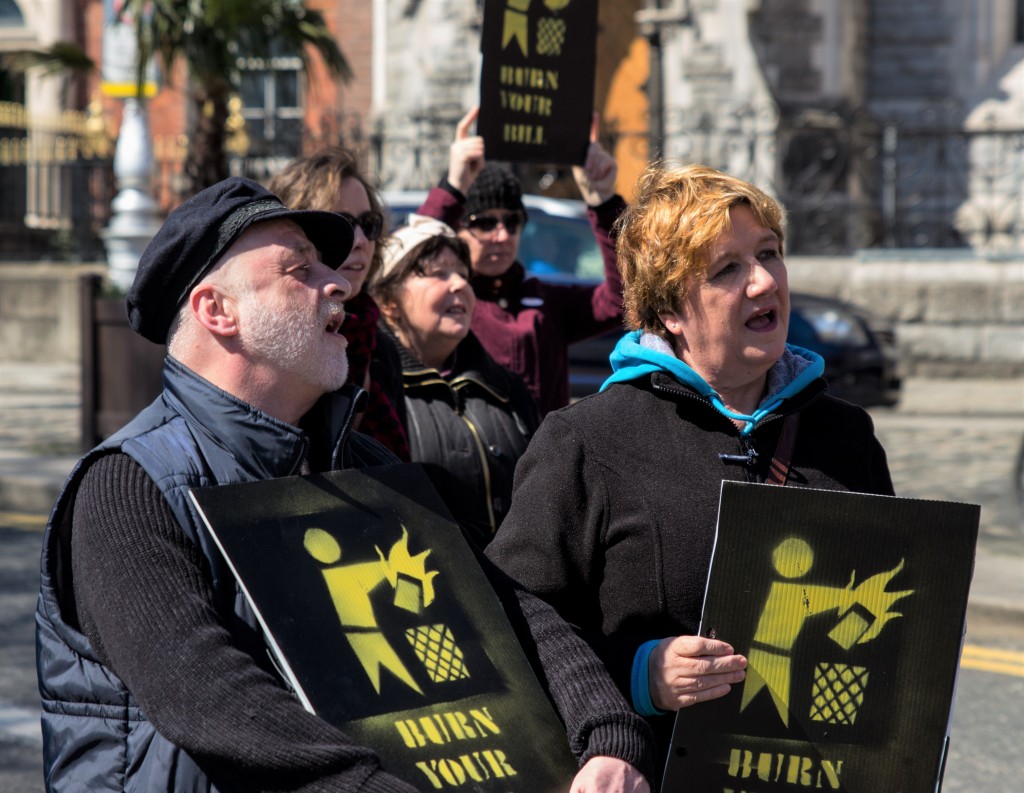
When a photo of Alan MacSimóin appeared on my phone screen on the morning of December 5th, 2018 I wondered if, perhaps, Alan was on his way to Cork. Occasionally, he would ring earlyish in the day to say he would be in Cork around lunch time, if one of his jobs took him in our direction. Admittedly, it was less common in recent years but that’s what came to mind when I saw his photo. I thought, great, it would nice to see him and have a chat. However, as soon as I heard dear Mary Muldowney’s voice I realised that something serious might be wrong. I still didn’t fear the worst, it didn’t even occure to me, but I was wrong.
In the days since the news broke of his death there has been outpouring of affection for Alan online and elsewhere. Some beautiful, lovely and appropriate things have been said about him, that to some extent underline the impact that he had on our lives and the high esteem in which he was held by so many people around Dublin, in the wider political community and, of course, by his many, many comrades in the anarchist and socialist movements, here in Ireland and around the world.
Today, however, we are here to say goodbye to Alan. It seems fitting then to talk about his outstanding qualities which I believe will ensure that he lives on in our lives and memories long into the future.
A Dangerous Dreamer
It is not often said about Alan, but in fact I think it was central to who he was and to his life: Alan was a dreamer. He was a dreamer of the most dangerous and beautiful type because he believed in the ability and capacity of ordinary people to change this world for the better. He knew of and could speak about many instances when ordinary people, the working class, had done this, and it was that vision, dream if you like, that in a sense was the light along the road he took.
To each according to their need, from each according to their ability. That is what he subscribed to. It is a phrase worth dwelling on for it holds within it the basis for a just and non-destructive existence on this planet. When Alan first got active in politics, which, has been pointed out elsewhere, was at a young age, he was coming into political life when optimism for change was growing and the potential of activism seemed high. He leaves us at a time when inequality has reached criminal proportions, when the future destruction of life on this planet has become a real possibility to all but the obtuse. The problems we see around us now, Alan would have laid rightly at the door of capitalism and I think he was right.
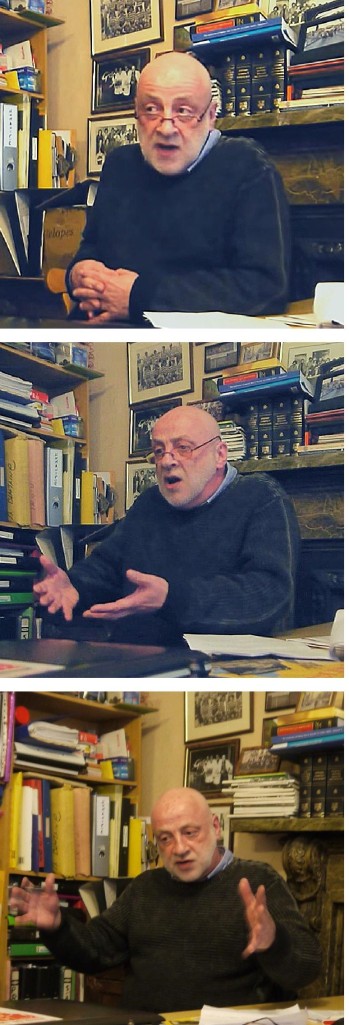
But he saw an alternative and he spent much of his life working for this, helping in whatever way he could to popularise hope and to convince those around him that, in the words of the anarchist Proudhon, “The great are only great because we are on our knees, arise”.
Alan was an anarchist, and in that movement the Spanish anarchists have a special place. So, it is to them that I turn to put this to you more succinctly. Shortly before he was killed in the famous defence of Madrid, the same battle that was to give us the immortal words “No Pasaran”, words that now seem very relevant in our lives once again, the anarchist activist Buenaventura Durruti was asked for his views on the difficult matter of building a new society. Contrasting the destruction wrought by the Civil War with the high goals they were fighting for, Durruti said that more than anything else, ‘He had a new world in his heart’ and ‘that it was growing at that very minute’. I believe this is entirely accurate of Alan too: he had a new world in his heart.
Practical
At the same time, Alan was an immensely practical man; some might say too practical. Many will have seen this side of him. While it is true to say that you cannot go anywhere without a dream of what the future should look like, Alan’s view was that you had to ground your politics in the practical. We have only to look at his own contribution over many decades to know that this was not just words with him. He opposed racism, fought sexism, fought for women’s liberation, opposed imperialism. However, he was perhaps nowhere as committed as with the struggle of his fellow and sister workers. He was a worker of course and throughout his life an active trade unionist. He was involved in countless solidarity and support events for other workers, those in unions and not in them. His contribution in this area is legendary and will never be forgotten. It is a contribution underlined by the honour bestowed on him today by SIPTU in providing Alan with a guard of honour on this his final journey.
But he was practical in a different sense too. When a number of us began meeting to consider the idea of setting up an anarchist organisation here in Ireland, it was Alan who insisted on the idea that we should plan the process, take our time and be clear about what we wanted. He was the one who rooted the movement in its early days in an appreciation of what being organised entailed. I know when I first got involved with this project, I was enthusiastic but without any real sense about what to do about anything. In the early days Alan was central in setting a course that took us immediately in the right direction. I believe that this will be one of his lasting contributions to the movement that he played such an important role in.
Workers Solidarity
He had a magnificent grasp of what the world was like and wasn’t under any illusions. He more or less wrote the trade union paper for the organisation, the Workers Solidarity Movement and several others too. Which leads me on to another aspect of Alan and this was his intelligence, depth and wealth of knowledge. Which I might add he gave of willingly and which we spent freely. I have to say it was only occasionally in later years that I thought about the possibility of him not being there one day. Now that time has come.
I asked a number of people who knew Alan about what they thought about him and one of the responses that I frequently received was, ‘I learned a huge amount from him’ Or ‘he knew such a lot’. I think this was another somewhat underappreciated side to him. Being a socialist or anarchist is about having the courage to stand up and fight for justice, but it is also about education. It is important to explain, teach and share your knowledge and he excelled at that. He fundamentally believed that changing the world involved convincing people that socialist and anarchist ideas were the ones to live your life by.
During one of his final working visits to Cork, so to speak, we invited him to talk about the engaging subject of anarchism and marxism. I was once again struck by how comfortable he was talking about what is a complex question. He was funny and immensely knowledgeable. He used the occasion to take a few swipes at those who were, he said, ‘blissfully ignorant of reality’. He was entertaining and it was easy to see that he enjoyed giving the talk too, sharing what he felt where the lessons of history in an open way.
Alan was always prepared to play his part. He was ready to stand on a picket line on a cold winter’s morning or to hand out leaflets to passers-by outside the GPO on a Saturday afternoon. But he complemented that practical activism with regular contributions on matters concerning strategy and tactics. If a campaign or struggle was not going to succeed, he was often one of the first to call time on the effort. Not because he no longer believed in the justice of the issue but rather because he preferred to put his resources into activities that could materially and politically advance the ideas that he believed in. He suffered defeats but he was a vital part of a number of very important victories. Two stand out and need to be noted: his involvement in the national anti-water tax campaign which succeeded in stopping austerity and, secondly, his involved with Repeal 8th. He played an important role in both these victories as an activist and as an organiser.
Victories
In the early days we used to tease by saying things to him things like, ‘So Alan, what was it really like during the Paris Commune? Or did you know any of the sans culottes.’ And when he’d refuse to answer we’d move on and say to him. ‘Well if you won’t talk about the Paris Commune then at least tell us about the Russian Revolution.’ I guess this was a roundabout way of acknowledging his wisdom.
I would like to particularly thank Mary Muldowney, Alan’s sweetheart and soulmate, and Alan’s close family, all his children and loved ones, for minding Alan for us all over these years. Alan loved politics but politics can be a hard business and it has its ups and down. Alan loved his family and they meant everything to him. We are grateful for the love and support they gave him over many decades of activism.
To return then finally to what I said at the outset, Alan was a dreamer so let us keep his dream alive and continue the struggle for it. The spirit of revolt lives on and will always live on, comrades, family and friends. As will Alan’s memory. His contribution is assured, his place in our history is a given.
It is with the greatest sadness then that I say goodbye to my closest friend and comrade, a gentle revolutionary who gave an inestimable amount to our movement and to the cause of the oppressed.
Slán, goodbye, adios and adieu, Alan.
Kevin Doyle
13/12/18
Glasnevin Cemetery
Don’t Worry, We’ll Be Back …
In the last number of years the Irish left has been involved in a number of significant victories – playing its part in the anti-water tax campaign, in the Marriage Equality referendum and in the Repeal 8th Amendment campaign. But defeat and defeats have also been part of our story.
How do we respond when we lose? This interview arose from a call by the journal Perspectives In Anarchist Studies for activists to talk about their experiences and their responses to defeat. Specifically this interview examines the Free The Old Head Campaign and the children’s book that later emerged and was inspired by the campaign, The Worms That Saved The World.Q: So where is a good place to begin? A children’s story book emerging out of a campaign that ended in defeat? How, why?
A: A few reasons. First off, like so many campaigns and struggles that we are involved in we lost but we shouldn’t have. What I mean is that justice was not done. Rather we lost because the other side had deep pockets and they also had the police and the state on their side. They didn’t win because they were right or because that position had more validity than ours. Our campaign was a classic example of might winning out over right. So, I suppose, our book is a way of saying ‘We’re not done here actually’.
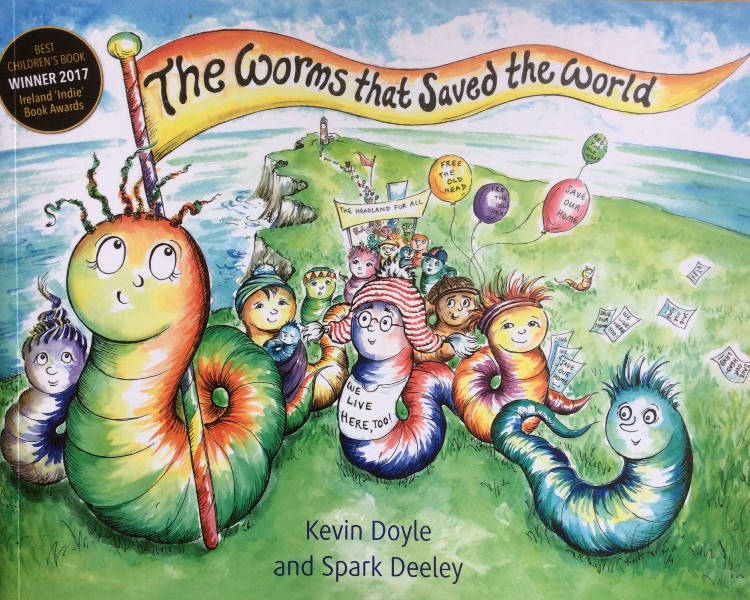
Q: Perhaps so you could tell us something about the campaign that inspired the book?
A: Sure. It was a campaign that happened here in Ireland at a location called the Old Head of Kinsale. It’s a beautiful promontory of land with walking trails, bird sanctuaries and magnificent views of the ocean and the surrounding coastline. It has been a traditional walking destination going back through the generations. For generations the land there was farm land with these wonderful walks around and at the edges of it.
Then in the late eighties the entire headland was purchased by a millionaire developer who had this dream of building a luxury golf course there. He wanted it to be exclusive too, just for those who had a lot of money. He was aiming at the top end of the golfing business – where luxury intersects with exclusivity and unparalleled scenic position.
“Many people wanted to preserve the headland as a public amenity and these developers wanted to effectively privatise it.”
A campaign got underway. Many people wanted to preserve the headland as a public amenity and these developers wanted to effectively privatise it. Our campaign – called Free The Old Head – emerged to take on the developers.
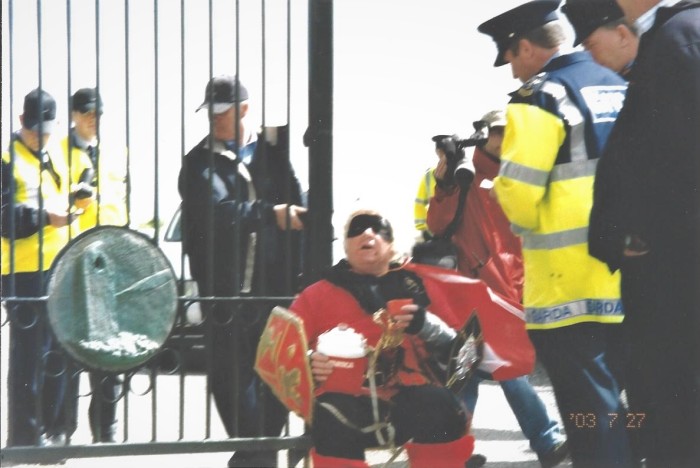
Q: How did the campaign go and evolve?
A: In truth it was always going to be an uphill battle to win against a determined group of developers. We were up against people with deep pockets. Essentially the campaign took the shape of a series of mass trespasses whereby people went to where the golf course was and insisted on their right to walk onto the Old Head of Kinsale. It was direct action and, at first, it was very difficult for the developers to stop the protest as they were large and defiant.
As soon as they did, the Irish police – the gardaí – rowed in to enforce the rule of law. It was touch and go after that. We really needed more public support and it didn’t arrive. So, in the end, public access was lost.
Eventually the developers went to the Irish courts, took on Cork’s County Council and Ireland’s Planning Board, both of which opposed the restrictions on the public’s right to walk in the area. In the courts the developers made many outrageous claims and tried to suggest that “The entire right to private property in Ireland was in dispute.” Mad stuff. But the courts, well, they sided with the developers. Surprise, surprise right?
Normally defeat spreads dejection and in our case there’s no doubt that was the case too. But it was really a highly spirited campaign despite losing. A lot of people mobilised. There were some really big protests. People scaled walks and climbed big wire fences. There was a strong element of direct action mixed in which what were called People’s Picnics which were very family friendly.

Q: Books about campaigns are not uncommon. Why did you choose the idea of a children’s book? Why that angle?
A: A few reasons really. I suppose from the purely practical point, there’s a lot of creative space within fiction writing. Even more so in children’s fiction. It struck us that the fight at the Old Head of Kinsale was in some ways a metaphor for our times. It was a conflict involving the public good up against private greed. On this occasion privilege and greed won out but we have to remember too that this cannot continue to be the case. We must start to win. The “public good” must begin to win out against privilege and greed. We cannot keep losing all these battles.
So subconsciously there was a feeling, for me anyway, to write about it and imagine the alternative.
What happened at the Old Head of Kinsale moreover seemed to be perfect material to bring back to life in an imaginary way. So in our book, the story is carried forth by a community of earthworms. They live on an imaginary headland – on Ireland’s Atlantic coastline! – that is invaded by a luxury golf course development. Pesticides and insecticides are used on the land and soon the worms are getting sick. However, they are rebels and they speak up. They ask for consideration. The result is that the developers try to eradicate them. The earthworms make a valiant escape but they know they have little hope on their own. A seagull – normally one of their predators – helps them, and this is how they make their grand breakthrough. They realise that they need to get help so they set off to tell their story. They build a movement … We won’t tell you the end but they do win!
The book is aimed at children but adults really get it too. It’s nice to imagine winning, and that one can. Another reason why a children’s book seemed ideal was that children don’t like injustice. When you talk to children about saving the planet from greed, you really are pushing an open door. And we want to tell a story that is optimistic about the possibilities ahead. Even though they can sometimes appear bleak.
I guess, when we tell stories or sing songs about injustice and fighting back, we are in part administering therapy and in part defying the impact of defeat. Stories and songs are resistance and therapy.
Q: But the book is primarily aimed at kids?
A: Yes. Most definitely. It is an illustrated book in the best sense of that word. The artist who created the illustrations, Spark Deeley, did a wonderful job. The illustrations have a lot in them, and within some there are more stories – like the one where the worms have a mass meeting.
Also the story is dramatic. The worms have to fight to survive. It’s an adventure and they make it through in the end. So it’s an adventure book too.
It is fair to say though that it is an “alternative” adventure book. I suppose it fills a gap in the book market. That was another side to why we chose to do a kids book.
Many activists are parents or will be parents or child-minders at some point in their lives. While the campaign to Free the Old Head was ongoing, I had young daughters myself. I’d be the first to say that there are some really great books out there, but there is a dire lack of books like ours about things like this too.
Q: You mentioned a few reasons?
A: So many story books reinforce and uphold traditional values. This has been exposed in recent times around gender roles in particular. The video “The Ugly Truth About Children’s Books” is a great example. It’s on YouTube and well worth a look. A mum and her daughter remove books from a bookcase using the following criteria: Is there a female character? Does she speak? Do they have aspirations or are they just waiting for a prince? In the end there’s not a lot of books left for the mum and daughter to read. One bald fact tells you a lot: 25% of 5,000 books studied had no female characters at all. So across the board for a range of children’s media, less than 20% of products showed women with a job, compared to more than 80% in respect to male characters. So around gender roles we can clearly see biases in operation. Do these biases help in perpetuating a whole range of disparities that women and girls suffer in society? Of course they do. Conservative socialisation is all around us, and dominant in so many spheres of life.
Moving away from gender temporarily, why would we be surprised if there were similar biases around topics like poverty, exploitation or challenging authorities. Of course there are.
“The book is an imaginary celebration of fighting the good fight for justice. In our story – as you can see from the book’s cover image – the earthworms are happy rebels.”
So in another way, in responding to what happened in our campaign in Cork, we are also addressing other issues not actually disconnected from our general struggle against injustice. People are passive and accept injustice often because they are socialised from a young age to be that way. We need to broaden the scope of radical ideas and alternatives. The area of young children’s fiction, seemed an obvious place in a way. Also an important place. Children matter and they listen and question. We want to link up with that I suppose.
We’ve described our book as “Direct action for kids,” and that’s what we think our young citizens should know more about: in life, to be effective, direct action works.
Q: In the promo piece you say “A book for adults too” right? Can you talk about this?
A: Adults can clearly see the simplicity of the story. It is a bit of a good versus bad tale and none of the dreadful complications of adult life are really there. But adults like the idea of passing on their values to children, and this book offers opportunities for doing that.
Questions arise from any good story. So in our book, community and solidarity become central issues in survival. The importance of standing by people if they are picked on by more powerful people, by bullies if you like, is also part of the story. Children sadly are quite familiar with bullies, so this book is able to speak to them about this issue too.
A key anarchist idea is in our story also, by the way. In fact the plot turns on it. This is the idea of mutual aid. Species on our planet coexist, and there is cooperation, but do we hear much about that? Children hear lots about competition and the Darwinian idea of the survival of the fittest. So again there is room in the story to look at the idea of cooperation and how humans must in the end cooperate and respect the value of the environment.
So there’s room in the book for adults to talk and explain to children about different things that arise. Or you can just read it for the adventure and fun of it.
Q: A lot of positivity from defeat then.
A: Sure. The book is an imaginary celebration of fighting the good fight for justice. In our story – as you can see from the book’s cover image – the earthworms are happy rebels. The cover image by the way is from a point in the story before the worms have claimed outright victory. So, via the image, we are reflecting on that very important fact that we sometimes overlook: it is important to fight injustice but it is often fun too!
I mean, many of know this at a personal level in that we meet some great friends in campaigns, and we meet some really decent comrades. But joining with others, taking part, enjoying participatory democracy, we get to live life. So the book is a celebration of rebellion and the rebellious way too.
Q: Has the book had an impact on the original issue at Kinsale?
A: Locally it has revived interest in the issue at the Old Head. With the passage of time, the loss of this amenity is felt more acutely. There is a sense that the community was “robbed” and in a way it was. Also other cases have emerged. For example, Donald Trump has a golf course that is involved in controversy in another part of Ireland. There is a golf course in Scotland with a similar tale of woe to tell, also linked to Trump I think. People have told us about other cases similar to ours that are really about the same type of thing: the greedy 1% taking away from the public space. So it has brought an awareness that what happened at the Old Head is about a lot more than just something in our locality.
Another interesting aspect has been the positive response from many of the activists from the campaign. They have really helped to promote the book. I think many of them are proud that their fight has been celebrated with a book of its own.
Q: Some final points?
A: A couple that are related I suppose. Firstly we have to play the long game if we want to change the world. I know some ask, is there time? Well, we need time too. There is a war of ideas out there and neo-liberalism is very pervasive. We need to get in there now. Books are one way of doing that because books are powerful. That has been known from time immemorial. So our book, The Worms That Saved The World, is part of the long game. We want to influence young people and have them think early on about the idea of standing up for their rights.
But let’s go a step further and ask what do you do about your rights if the authorities and the courts say NO? If they say to you your rights don’t matter. Our book goes into that and it is unequivocal. If you rebel, think about how to win and what winning entails.
Educate, spread your ideas and build support. It’s one of the lessons that emerged from losing at the Old Head of Kinsale. We didn’t do enough of that before the crunch came in the fight there.
At the very end of our story, the worms celebrate and they say, about their victory, “We did it together.” That says it all.
This interview was first published in Perspectives on Anarchist Theory 30: Beyond The Crisis.
The Worms That Saved The World by Kevin Doyle and Spark Deeley was published in May 2017. It is distributed worldwide by AK Press (Oakland) and AK Press (Edinburgh)
Socialist whodunnits, the Catholic Church and being ‘left in the lurch’.

Occupy march, Cork 2011
Q: To Keep A Bird Singing begins during the Crash in 2010. Noelie and Hannah, two of the main characters in the story, are keeping their heads above water. We meet Noelie for the first time in a charity shop. Was there a specific reason why you chose that time period for the story?
A: The Crash here in Ireland felt like a reckoning, the past catching up with us and exacting revenge. There had been so much hot air around the Celtic Tiger and that it had heralded a new dawn in Irish history – we were a country that people were immigrating into rather than emigrating from for a change. Then, that ended. Austerity, cuts, unemployment, mass emigration all over again. A time of reckoning is a time when you look more closely at what’s going on around you; maybe it’s a bit late in the day but you do it anyway. I think that’s some of the backdrop to the story.
Q: And Noelie and Hannah?
A: They are ‘stayers’. What I mean is that when the Crash hit, people left in droves once more. It’s national affliction 😉 ‘Oh there’a problem here, right I’ll be off so.’ However Noelie is older, in his late forties when the story gets underway. He’s been made unemployed, as many were, and he feels less able for emigration. He has to stay and that means he is more prepared to ask questions about the Ireland he is stuck in. Which is what gets him into trouble.
Q: It isn’t clear at first what Noelie has stumbled in to. In the beginning the story is light-hearted. He finds his missing punk records collection. It seems like a lucky break. Then matters rapidly descend into danger.
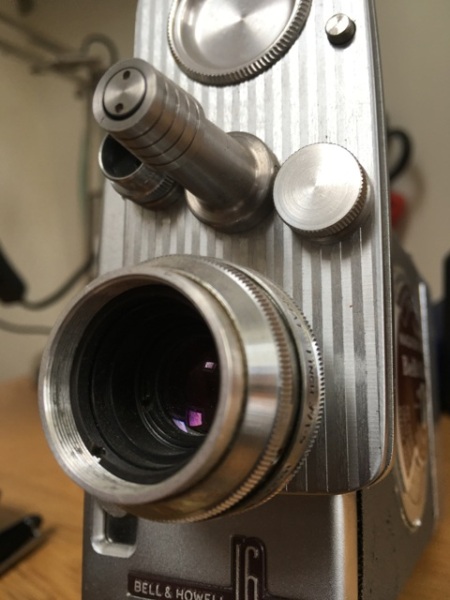
Bell & Howell Home Movie Camera c. 1960
A: What do you do when the cops are the criminals? It’s a problem, right? The normal avenues of complaint aren’t open to you. In To Keep A Bird Singing, Noelie and Hannah learn about the plight of a local man, Jim Dalton who has gone missing. It soon becomes clear that the cops, Special Branch that is, are probably involved. That’s how the story gets going and that’s when things really start to get difficult for them.
Q: So the cops are not heroes?
A: There is one very good cop in the book but he’s dead. Another more minor character, a police woman, is also portrayed in a positive light. So they are not all bad. Far from it. But the story in a way is about those elements of the police involved in the secret state.
Q: Which means what?
A: The activities of Special Branch and others elements inside the state security apparatus who are a law onto themselves. In the UK you have had the likes of Mark Kennedy and his involvement in deep infiltration, targeting left-wing groups, trade union activists and environmentalists. Absolutely corrupt, disgraceful activity sanctioned high up inside the police force. In Northern Ireland too all sorts of criminal activities were engaged in by RUC Special Branch. Collusion with Loyalist paramilitaries in conjunction with M15. Sectarian killings were orchestrated to stoke up sectarian hatred. There was state involvement with death squads. And we shouldn’t forget what happened at Kincora House in Belfast where elements in state security knowingly looked the other way when informed that child abuse was taking place.
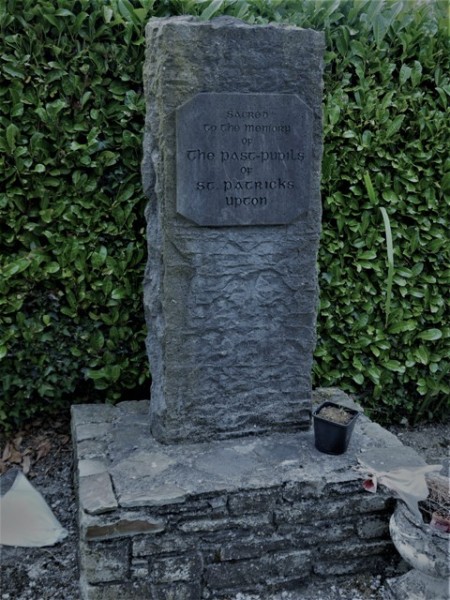
Memorial at St Patrick’s School for Boys [Upton, Co. Cork]
Q: Pretty ugly.
A: It doesn’t get much uglier.
Q: The book has been described as a socialist whodunit. Is this because of the focus on this secret state?
A: Ellie O’Byrne in the Irish Examiner called it that. I guess it is the issues that arise in the story but I think it is also a description that emerges from the characters in the story. The Crash has hit and both Noelie and Hannah are feeling the pinch. However both of them have activism in their background – of the grassroots kind, I mean. Noelie in particular was stuck in a campaign against the Council’s decision to privatise rubbish collection and so on. The anti-austerity protests are also in the air as the novel opens, and Noelie’s thinking of getting involved. The key characters are lefties.
Q: They cross swords with powerful people. The shadow of the Catholic church is there. The business community is also close to hand. What sort of Ireland is this?
A: Things are changing in Ireland – as evidenced by recent victory in the repeal of the 8th Amendment here [which banned abortions in the Republic.] However the Catholic Church is still a powerful force in terms of its wealth, influence and its connections. It still commands in sectors of the health service and in education. So the power of the Catholic Church is also the backdrop to the story.
Q: Noelie and Hannah could walk away from the trouble they see but they don’t?
A: They live in an Ireland where a lot of things have been swept under the carpet. The story is set in 2010 but in terms of the book, a year earlier a ground-breaking report had come out about the industrial school network in Ireland – the Ryan Report. This set out for all to see how brutal and vicious the systematic punishment of poor families and children had been in Ireland at the hands to the state and the Catholic Church. Another report in the air as the story gets underway has to do with the Catholic Church’s role in child abuse and in protecting clerical child abusers in the Dublin Archdiocese. Noelie and Hannah are living in an Ireland where it’s getting hard to look the other way.
Q: Although some people remain good at that. 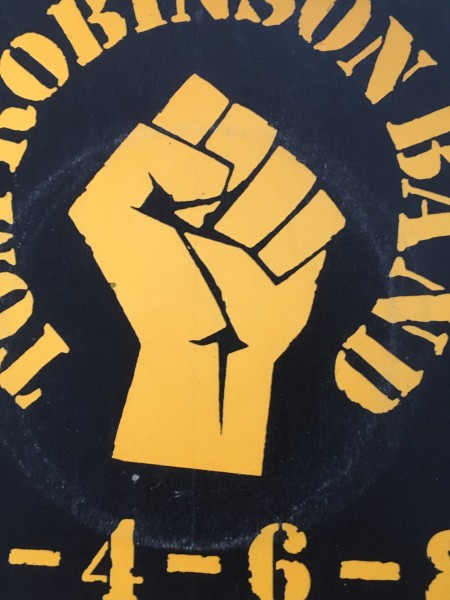
A: Indeed. But others stand up in extremely difficult situations when faced with injustice and wrongdoing perpetrated by the powerful. Sometimes – and I think we know this – standing up for what is right is, effectively, a death sentence and yet people do it. Near when I was finishing writing the book, the Honduran activist Berta Cáceres was shot dead by paramilitaries linked to state security. She was threatened with murder so many times but she wouldn’t give up. And they did murder her in the end. I think, for what it is worth, the story is trying to celebrate bravery but the bravery of the underdog.
Q: As To Keep A Bird Singing moves on we begin to see something a lot darker – a group of abusers are possibly involved. They have protection though, from on high, from inside the Irish state. Is this based on a real situation.
A: The story is fiction and in another sense it isn’t. Did the Irish state protect abusers? Without doubt, yes. The Catholic church wrecked havoc on the lives of many children in Ireland right up until recent times. Abuse happened and often it was known that if certain children were sent to certain places they would be abused there. The courts not only didn’t stop this, it insisted on sending these children into these place and then, further to that, it then protected the abusers who abused in those institutions. Take the case of Fr Donal Gallagher. He was a notorious abuser and there were a myriad of complaints made against him. His order, the Vincentians, did absolutely nothing of substance to stop him. But the Gardaí failed repeatedly to pursue him too. There is a quote in the Murphy Report [p357] which really tells it all in my view.
The sergeant who conducted the investigation [into Fr Gallagher] stated in his report: “Fr Gallagher is a professional man and strikes me as a sincere and genuine individual. I can see no useful purpose to be gained by the prosecution of Fr Gallagher at this late stage”.
So I think you could argue in general that, yes, the Irish state by being so consistently negligent did abet child abuse. Was there a more sinister angle to some of this convenient ‘negligence’ on behalf of the Irish state or people acting on its behalf? I think we’d be naive not to think so.
Q: Do you think your own politics has helped in writing the book?
A: Hugely. Your politics determine what way you look at the world. In crime writing and so on its hard to avoid politics in some way. Even the murder, mayhem and gore brigade deal with it because it is all around in almost anything that goes on. But ‘political’ crime in sense of criminality deriving from how society is structured, from the reality that we live with under capitalism, gets off very, very lightly. You have to go to the Continent, to Italy and France to find any substantial body of work. That’s the way it looks to me anyway. But there is also a certain amount of ‘feed people what they are used to eating’ attitude around too. The popular impression of crime is that it is mostly constituted by gangland based violence or vicious person-on-person crimes in which women in particular appear to come out the worse. ‘Political’ and ‘white collar’ crime, apart of course from people supposedly ripping off the dole say, is largely ignored. I remember an example a few years ago, to do with crime book related to the chemical industry. As I know something about the area I thought I’d have a read. Now there are no end of examples of pharmaceutical and chemical corporations plundering the environment to maximise their profits – engaging in criminal activities to get their way too. But who was the criminal in this book? It turned out to be a crusty environmental activist who having lost his bearings decided to pollute an entire river to get the local chemical plant in trouble. I mean really like. In other words plots that fit certain tropes which coincidentally just happen to support the status generally do better with agents and publishers. Big surprise?

Edward Snowden broke the bad news.
Q: Surveillance features as an important element of the story. But it only become clear as the story crisis deepens that it is having a crucial role in what is going to happen.
A: I think that’s it. If you don’t resist surveillance isn’t really an issue for you. If you do resist then the surveillance becomes a real factor that you have to contend with. Nowadays the state is able to spy right into the very heart of our lives and when it needs to it does so with a tap of a keyboard.
Q: In To Keep A Bird Singing, Noelie and Hannah don’t know who their enemies really are. The people they are up against are ‘faceless’ and some continue to be until the end.
A: This is another reality. I mean one of aspects of recent human rights abuse – everything from drone assassinations to rendition etc – is that the perpetrators are never identified. The State has at its disposal hired killers who we – the public – have no right to know about. I mean if we look closely at this it is beyond shocking. This ‘legitimate’ secrecy that the State has reserved for its covert operation in our name is a grave threat to our security. In To Keep A Bird Singing the faceless nature of those behind one of the deaths is a key factor. Can one ever get justice if one doesn’t even know the identify of the criminal involved? If they are protected by state secrecy legislation it’s nigh impossible.
Q: The story ends on a positive note but only just. Would you agree?
A: The story is not over. In a number of ways actually. As was pointed out to me by a kind reader of the book, Noelie has been left in the lurch, romantically speaking. So at the very least that has to be sorted. Other matters too are there to be followed up. But yes at the end of To Keep A Bird Singing, Noelie and his friends have made progress but at a price. It’s reality, no? It is very hard to get justice without making a sacrifice. Everyone who fought for the freedoms we now have – from advances in working conditions to women’s suffrage – put a lot on the line. They knew they had to but importantly they thought and knew it would be worth it too.
** My thanks to ml for taking the time to do this interview with me.
Links Suffer the Little Children and Haunting Cries are informative and disturbing accounts of the industrial schools network here in Ireland.
Industrial Memories – A response to the Ryan Report
The Punk Bit …

I was a Stiff Little Fingers fan [c. 1980]
I was lucky to have an uncle who lived in Paddington and he attended the market religiously on Friday and Saturday morning every week. My brothers and I often went to stay with him in the summer months during the seventies and through that I got to know the ins and outs of Portobello market in west London: where the ‘tourist’ end was and where the locals went. Under the Westway flyover, there were often plenty of punks and lots of punk records, new and second-hand, to be had; I spent a good deal of time there sifting through the records stalls. Further down the market , in the direction of Notting Hill, there was Rough Trade of course – another Mecca for anyone interested in punk back then.
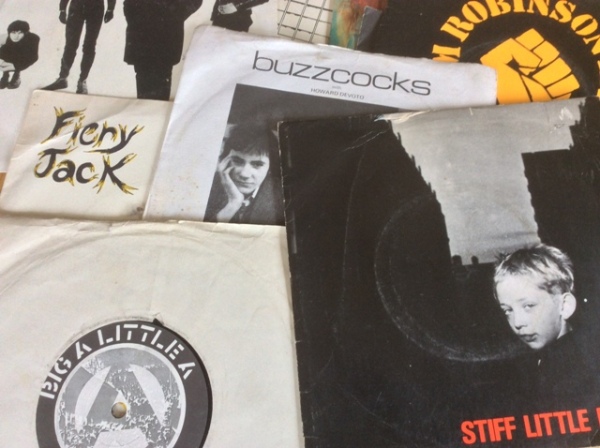
Thankfully my collection of 45s survived the theft.
Douglas Street
Being broken into is an unpleasant experience. I was living on my own in a fairly decrepit flat on Douglas Street when it happened – working my way through my Masters when the theft took place. Some money was taken and a few other bit and pieces but the record collection’s disappearance was the big loss. I can’t remember for sure now but I think the thief was caught – he attempted to cash a cheque from a campaign cheque book I was holding; I tended to volunteer then for jobs like ‘treasurer’ or ‘secretary’ – and after being told to return to the bank with ID if he wanted to cash said cheque, he did and was duly arrested. He never revealed where my prized collection was however and, as I recall, the garda detective involved was not that interested either.
I spent awhile haphazardly combing through various second-hand record stores in Cork hoping to spot one of my treasures, hoping indeed to see any part of my collection again but I never did; the records were gone and I suppose were soon dispersed in every direction. That, in a sense, was the end of the story.
Charity Shop
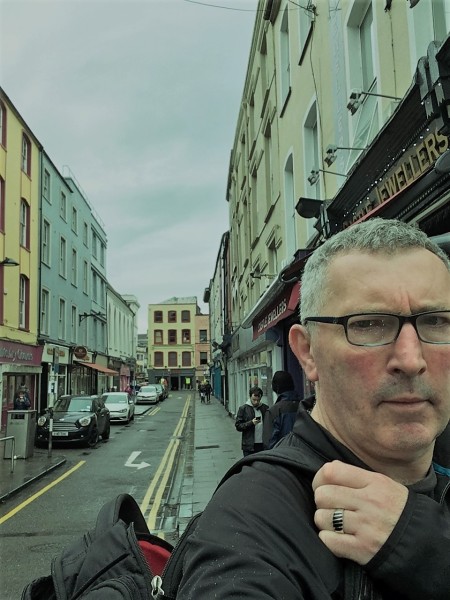
Castle Street, Cork
Years later and at a very different stage in my life, my record collection came back into my mind. By then I had two children and they were attending The Cork School Project (Educate Together) located on Grattan Street in Cork. I often dropped them to school and collected them later to bring them home again. This involved walking through town and one shop of particular interest that we often passed was on Castle Street (pictured) off North Main Street. A charity shop along the street was well known for making an art form of its interesting window displays.
This was the noughties and records and LPs were not yet back in fashion as they are now. There were boxes of vinyl lying on sale at giveaway prices in the shop and I often checked them, somewhat absent-mindedly, but with an eye for any of the gems that I had lost all those years ago. I wondered about the idea of finding my collection again and what that would feel like after all this time. It would be strange and odd too, right? Now what if I found the entire collection still intact, what would that mean? It never happened but I did have an idea for how a story – probably set in Cork – could begin. All this time later it is how To Keep A Bird Singing begins.
Related Links
Review of Living Anarchism – José Peirats and the Spanish Anarcho-Syndicalist Movement
Living Anarchism – José Peirats and the Spanish Anarcho-Syndicalist Movement by Chris Ealham [AK Press] Available here.
This review first published in Ideas and Action (Oct 2017).
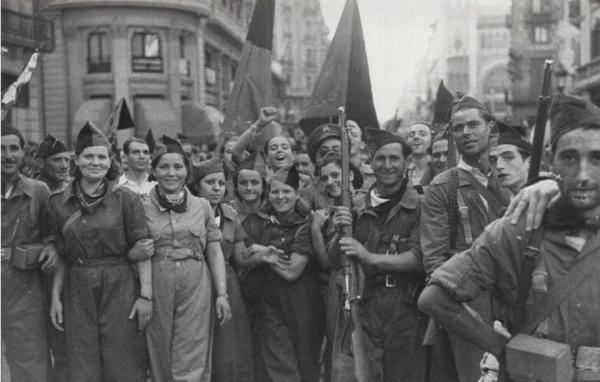 On the cover of Living Anarchism, the publishers, AK Press, point out that the anarchist movement in Spain in the lead up to the revolution in 1936-37 was the ‘the largest anti-authoritarian movement’ ever created in the world. It numbered in the hundreds of thousands and resulted from a conscious and deliberate intervention by anarchists in the everyday world of work and community. Anarchists sought to build a new world in the shell of the old and they were surprisingly successful in significant ways. Living Anarchism is testimony to this. Not a history of Spanish anarchism as such, it is nonetheless a window into the life of that movement seen through the life of one its key activist, José Peirats.
On the cover of Living Anarchism, the publishers, AK Press, point out that the anarchist movement in Spain in the lead up to the revolution in 1936-37 was the ‘the largest anti-authoritarian movement’ ever created in the world. It numbered in the hundreds of thousands and resulted from a conscious and deliberate intervention by anarchists in the everyday world of work and community. Anarchists sought to build a new world in the shell of the old and they were surprisingly successful in significant ways. Living Anarchism is testimony to this. Not a history of Spanish anarchism as such, it is nonetheless a window into the life of that movement seen through the life of one its key activist, José Peirats.
So who was José Peirats? The son of labourers from Valencia province, he moved to Barcelona at a young age with his family in search of work and a future. Suffering illness and numerous privations, Peirats eventually found a home in one of the city’s vibrant rationalist schools. However his education was short-lived and at a young age he entered the workforce proper as a brick-maker. Gravitating to the anarcho-syndicalist union, the Confederación Nacional del Trabajo (CNT), he became a key activist in the L’Hospitalet area of Barcelona. Peirats lived through it all: at the young age of 28 he was in Barcelona as the Spanish Revolution got underway. He witnessed the enormous achievements and hope that the revolution generated and he witnessed, in time, its demise and defeat. In exile at the age of 31 he spent a great deal of the remainder of life documenting the rise of Spain’s anarchist movement, going on the produce The CNT in the Spanish Revolution – an extensive, three volume history of the largest workers’ union in Spain at the outbreak of the Spanish Civil War. In the last period of his life he said,
“I’ve done almost everything in the CNT: I’ve organised strikes, organised workers, spoken in assemblies, meetings, and given conferences, written articles, attended congresses, used pistols, and, some- times, explosives; I’ve been in jail and collected lawsuits, mainly for libelous press articles. I know what it means to be naked and take a beating in a police station. I was the only secretary of the CNT in exile to enter Spain clandestinely when they were still shooting people!”
 Living Anarchism is broken into ten sections (if one includes the excellent summation) which can broadly be divided into two parts – the period leading up to the revolution and period after the revolution’s defeat. If the first section of the book is then a celebration of what anarchism was capable of building when its activists put their minds to it, then the second section is, in contrast, the tragedy of defeat at the hands of fascism and what that came to mean.
Living Anarchism is broken into ten sections (if one includes the excellent summation) which can broadly be divided into two parts – the period leading up to the revolution and period after the revolution’s defeat. If the first section of the book is then a celebration of what anarchism was capable of building when its activists put their minds to it, then the second section is, in contrast, the tragedy of defeat at the hands of fascism and what that came to mean.
Exile
Exiled to South America and later France, Peirats struggled like many of his comrades to make sense of the defeat that had befallen the anarchist movement in Spain. Defeat is never easy and the tragedy was compounded by exile and isolation. A movement of Spanish anarchists abroad came into being but it was riven with division and acrimony. Peirats, more than most, understood the dilemma: the past could not be ignored and yet the movement, if it was to survive and rebuild, needed to move on too. It was a delicate and difficult line to walk along.
Peirats was clearly a product of the university of the class struggle and his early years and reputation as a resolute union activist in the cauldron of Barcelona was something that he never departed from. However, another side to the activist was his strong interest in the practice and spirit of anti-authoritarianism. A significant part of his life – perhaps deriving from his own early exposure to the rationalist/ free school movement in Barcelona – involved a commitment to the ‘athenaeum’: essentially self-organised community centres envisaged as ‘a focal point of social ferment’ for the locality around it. These centres hosted a library, debates, music recitals, evening classes and threatre productions. Before and during the revolution, as well as afterwards in exile, it was this activity surrounding the ‘athenaeum’ that Peirats returned to and was involved with again and again.
Although the person who emerges from his book appears exceptional in many respects, Peirats would have been the first to dispute this, it seems. Describing himself at one point as a ‘worker ant’ he believed himself to be very much a part and a product of the CNT. Clearly he was a talented activist, writer and organiser, but there emerges from this biography a man whose dedication to revolutionary change was absolute. By no means without faults – and this is explored in Living Anarchism – Peirats nevertheless had an abiding grasp of the importance and value of anarchist ideas. Given that he had witnessed the highest point of achievement and an avalanche of low points in its aftermath, he remained largely upbeat, understating near the end, ‘I did what I could despite many obstacles’.
Durruti
In terms of Spanish anarchism we hear a great deal about people like Durruti but activists like Jose Peirats, it seems to me, were a lot closer to the soul of Spanish anarchism. For Peirats anarchism was about democracy, education and the class struggle. In contrast Durruti was far more liable to be off taking a pot shot at some bishop or other – a headline grabbing activity but not necessarily as productive as it sounds or looks.
In 2010, the historian Chris Ealham produced what is undoubtedly one of the best social and political histories of anarchism, namely Anarchism and the City – the story of the rise of anarchism in the Catalonia port city of Barcelona. Now with this account of Peirat’s life he had done us a further service. He admits at the outset that ‘there are many aspects of Peirats life that he finds admirable’ and while this must certainly colour this work, it does not distract from what is a clear and concise account of an anarchist activist’s lived life in revolution and defeat.
Matters have moved on hugely since the revolution in Spain in 1936-37 and Peirats as much as anyone saw this in full measure by the time his life came to an end in 1989. However there is a great deal to learn from this book. The Spanish anarchists combined a practice of militant class struggle with a broad visionary belief in human desire and emancipation. Whatever about claims, dreams and aspirations, in the end it takes people to make politics happen: Peirats was clearly one of those who excelled at this task.
A book to read and treasure.
Let our memories run through our veins …
 The grave of Federico García Lorca has never been found but it is believed that his remains lie in the hills to the north of Granada, Andalusia close to the town of Viznar. He was probably executed on August 19th, 1936 – 71 years ago.
The grave of Federico García Lorca has never been found but it is believed that his remains lie in the hills to the north of Granada, Andalusia close to the town of Viznar. He was probably executed on August 19th, 1936 – 71 years ago.
Lorca is regarded as one of Spain’s must important modern poets and dramatist and while his reputation was well established at the time of his death, it was not sufficient to save him from his fate at the hands of Franco’s henchmen. Although Lorca was left-leaning , he was also a gay man: these facts alone condemned him to an early death. He was one of ten of thousands who were murdered in Spain during and after Spain’s Civil War (1936-39) for no other reason than being deemed undesirable to Franco’s fascist regime. Today there’s a memorial at the site where it is believed that Lorca was killed..
Location
The easiest way to get to the site is to travel to Viznar itself, about six miles from Granada and then take the road going to Alfacar. About 3 km along, the road take a sharp reverse turn and makes its ways along a hillside; to the south there are views back to Viznar. A short distance from the turn, on your right (looking uphill or to the north), there is a layby (clearly sign-posted) where you can leave your car or bike. The general area is known as the Sendero Barranco de Viznar (Viznar Ravine Trail) and is popular with walkers and trekkers. Close by is a second signpost indicating that this area is important for other reasons too: Lugar de Memoria Historica de Andalucia [Place of historical memory].
Lorca
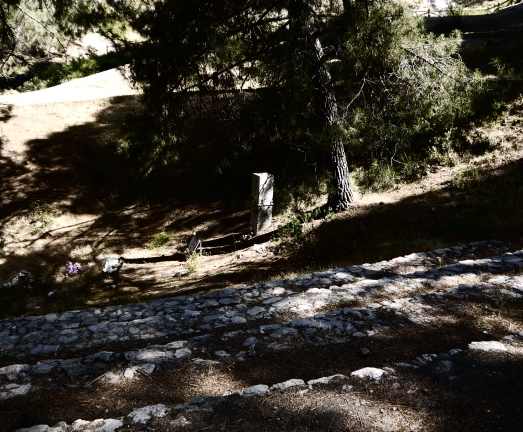 A path leaves the layby and winds uphill through an open pine forest offering shade. There are undulations and gullies on a both sides of the path. After about five minutes you will come an area of flatter terrain marked by a number of log fence boundaries. A flat low-lying slab of stone bears the inscription of a line from Lorca’s poem, Prelude – Love :
A path leaves the layby and winds uphill through an open pine forest offering shade. There are undulations and gullies on a both sides of the path. After about five minutes you will come an area of flatter terrain marked by a number of log fence boundaries. A flat low-lying slab of stone bears the inscription of a line from Lorca’s poem, Prelude – Love :
El viento esta amortajado
a lo largo bajo el cielo
[The shrouded wind lies full length beneath the sky ]
A short distance on there are a number of larger flat slabs which bear an array of memorial plaques. Some are dedicated to individuals such as that to Delores Rozalez Vinez – They Silenced Your Voice But Not Our Memory. Others are dedicated to lists of people executed in the quiet secluded area – Executed in Viznar Ravine on 23 October 1936 is followed by a list of thirty names. Further along there is a large gully. A square upright monolith stand at one end. Flowers have been left in a number of places and the monolith bears the inscription:
Lorca Eran Todos
18-8-2002
[Lorca was all]
There is stone terracing for sitting on. When we visited Viznar it was quiet and there was no one else around. Since the trees provide welcome shade from the sun, it is by no means an unpleasant place to stop at and rest for a bit. However, under the ground, lie the remains of many hundreds of people. Some have been identified but many remain unidentified. It is difficult today to imagine the summary violence that would regularly taken place at the site over many years following Franco’s victory.
Anarchists
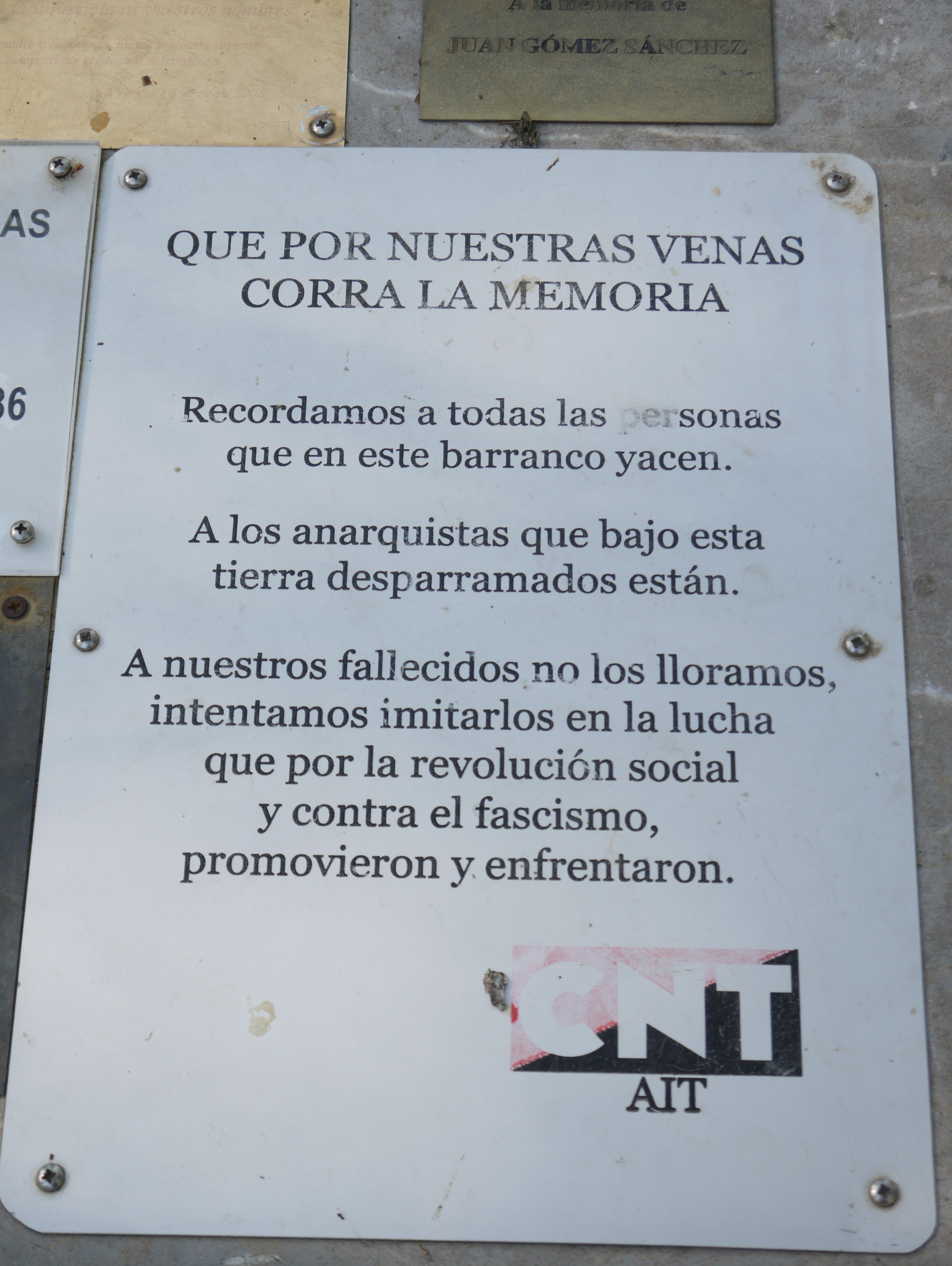 It is believed that Lorca was executed along with two well-known militants of the CNT, the anarcho-syndicalist union which was a leading force in the Spanish Revolution. The remains of these men – Joaquín Arcollas Cabezas and Francisco Baladí Melgar – have also not been identified. A plaque placed at the Viznar site by the CNT reads:
It is believed that Lorca was executed along with two well-known militants of the CNT, the anarcho-syndicalist union which was a leading force in the Spanish Revolution. The remains of these men – Joaquín Arcollas Cabezas and Francisco Baladí Melgar – have also not been identified. A plaque placed at the Viznar site by the CNT reads:
“Let our memories run through our veins. We remember everyone who lies in this gully. To the anarchists who are scattered under this earth. To our deceased we do not cry, we try to emulate them in the fight for a social revolution and against the fascism that they faced”
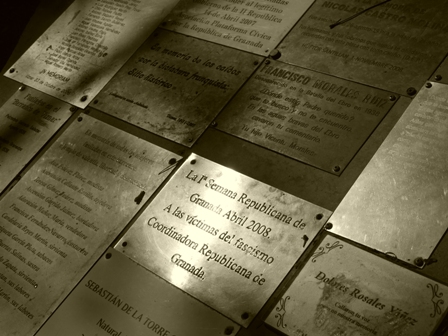 Various other memorial plaques are testimony to the broad range of people who were killed outside Viznar. Trade-unionists, left-wing activists, feminists, cultural activists and many, many others all fell victim to Franco’s knife. The context for the extermination was succinctly put by General Emilio Mola who stated at the outset of the Civil War what the point of the military uprising was:
Various other memorial plaques are testimony to the broad range of people who were killed outside Viznar. Trade-unionists, left-wing activists, feminists, cultural activists and many, many others all fell victim to Franco’s knife. The context for the extermination was succinctly put by General Emilio Mola who stated at the outset of the Civil War what the point of the military uprising was:
“It is necessary to spread terror. We have to create the impression of mastery eliminating without scruples or hesitation all those who do not think as we do. There can be no cowardice. If we hesitate one moment and fail to proceed with the greatest determination, we will not win.”
Although Lorca’s reputation is the main reason for the memorial at Viznar, many of the other plaques present at the site are as moving. Each and everyone tells a story of resistance and remembering. This one to Miguel Gomez Poyatos is a perfect example.
MIGUEL GOMEZ POYATOS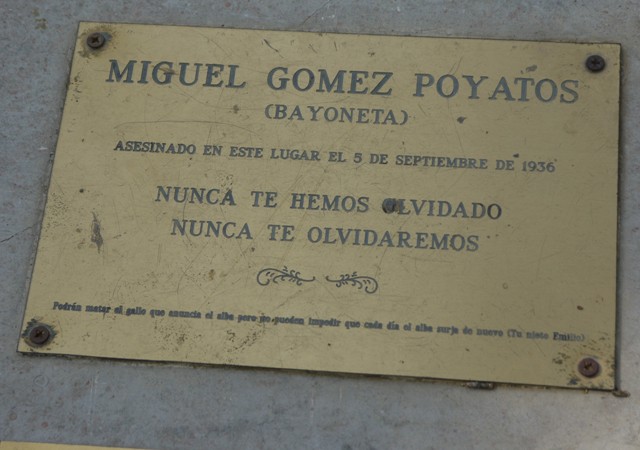
Murdered in this place on Sept 5th 1936.
We have never forgotten you
We will never forget you.
They may be able to kill the rooster
that announces the dawn
but they cannot stop that dawn arriving
(your grandson Emilio)
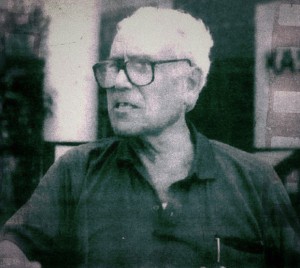
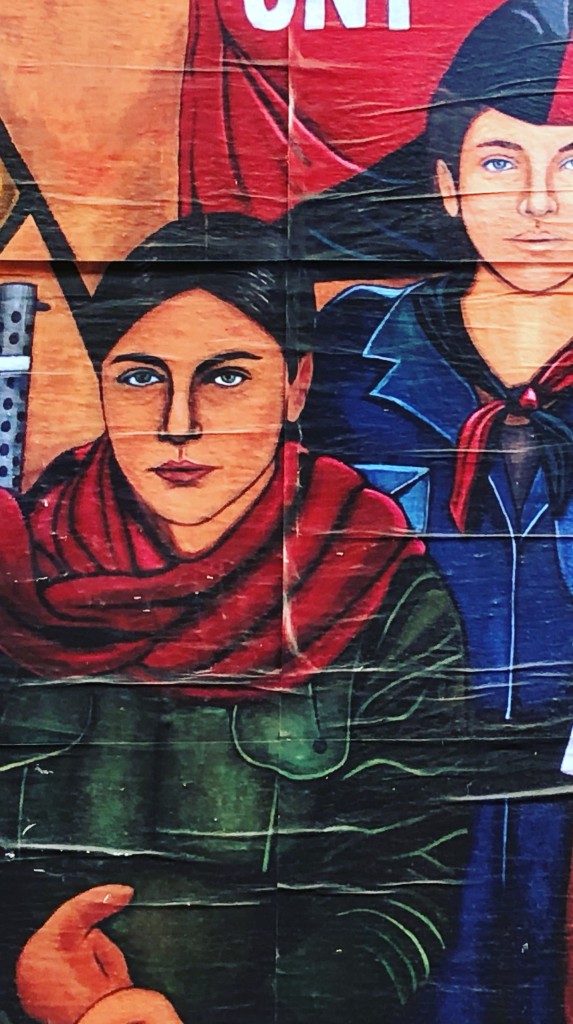

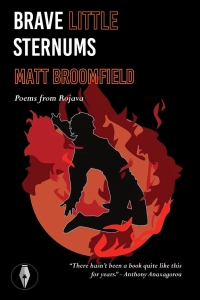
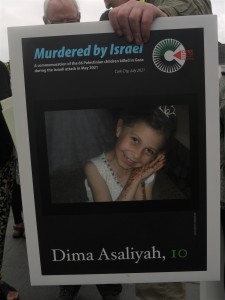
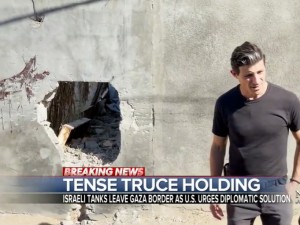



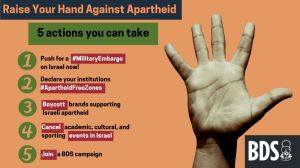

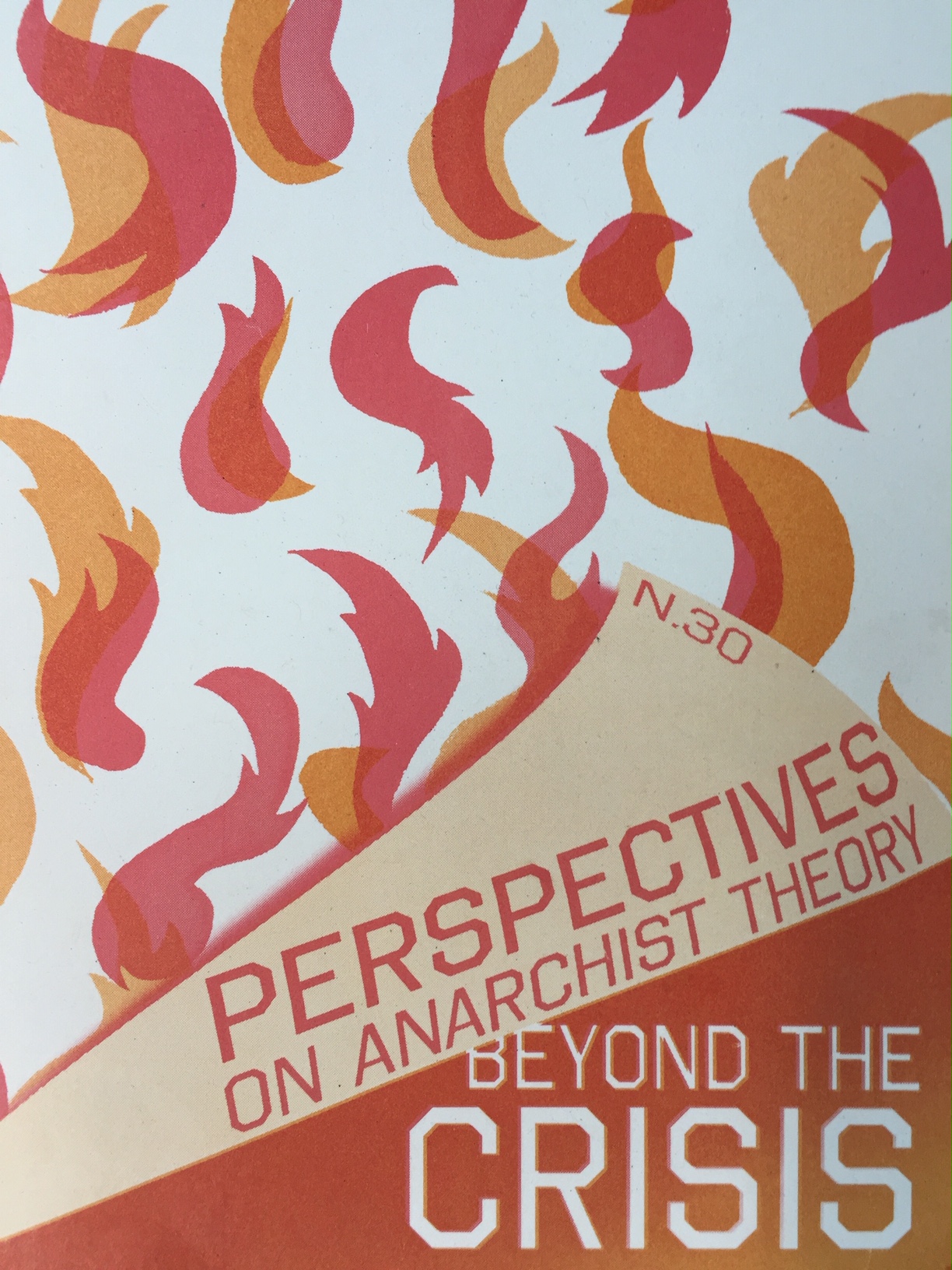




The Road To Letterfract
leave a comment »
I knew about Letterfract’s reputation. In part because I was in Galway and in part because I had been writing about the legacy of the industrial schools for a number of years, I felt I should take the opportunity to go there and see what now remains of the infamous institution. The school itself closed in 1974 and I wondered what, if anything, existed now that bore witness to what had happened there. I had heard that the original school building still existed and I wanted to see that. But what else was there?
STARK
Except that today Letterfract is anything but isolated. It is a busy, tourist-centred locality, a gateway to a multitude of adventure based activities involving the national park and the nearby coastline. Signposts direct the visitor to pub food, accommodation and to this company and that one offering different tourist experiences. Letterfract has had a modern make-over and in some ways epitomises the reinvention of Ireland’s western coastline. Here, in a place still wracked by emigration, a small community has clung on to assert a new way of using and making a living from the location’s natural beauty and amenities. On the day I visited, although at the end of the tourist season, there was a steady stream of people and activity around the shops and pubs. In the summer period I figured Letterfract got quite busy.
I understood that former industrial school was near the centre of Letterfact so I was surprised when I couldn’t find it. I realised that I had made a very basic error : the old industrial school building was there, dominating one quadrant of the main crossroads that is the centre of Letterfract. My mistake was that I was looking for a building fitted out in monochrome. Now, brightly repainted in red and yellow, the main building looked nothing like its former incarnation. In fact the building complex is now part of the Galway-Mayo Institute of Technology. A public park and picnic area in the foreground, screened by trees further helped to offset the domineering image that the industrial school once wore as a badge of pride. In the end, still unsure that I was in the correct location, I accepted that I was indeed looking at the former institution by virtue of the building’s position relative to Diamond Hill. Many of the iconic photographs of Letterfract Industrial School (see below) were taken with the austere peak in the background. Today that same vista is easily observed.
UPTON, ARTANE, BESSBOROUGH, TUAM …
It was a disconcerting sight – a place of abuse and a place where cruel punishment was meted out. Despite the passage of time, despite the make-over, it was hard for me not to think about what happened there. I was bothered too by the precise change of use: the former penal institution was now a part of a place for advanced learning. That seemed to me to be a travesty. The Letterfract building – because of what it was – has so much to tell us about ourselves. But that it seems is not of interest to some. I walked over to the main building. Close to where the old entrance was once located there is a plaque under the window with a poem on it: Show Day by Mary O’Malley. The poem, one of a series in the Letterfract Poetry Trail is a moving elegy to location and emigration. It can be listened to here.
Is there anything more, I wondered. There must be. I walked around. Students came and went. A group of young backpackers were picnicking on the grass despite the cold conditions. I wondered what they knew about this place. A casual visitor would not learn anything by walking around. There is nothing to warn anyone about what happened here; on the contrary in fact. I wouldn’t go so far as to say that an effort has been made to obliterate the past but there is doubt that someone is intent on not drawing any attention to what this place once stood for either. I was reminded of a visit I made to St Patrick’s Industrial School at Upton outside Cork a number of years ago – as part of research I was doing for my novel To Keep A Bird Singing. That complex is now a functioning day care centre in the Bandon area of Cork. I was told when I went there that it was not possible to walk around the main building for ‘health and safety’ reasons. St Patrick’s is another site of abuse where care has been taken to obscure the past.
GOD COULDN’T HEAR ANYTHING … AGAIN
It is not my intention here to trawl through Letterfract’s litany of crimes. One example will suffice to give the reader an idea of what the place was like. Taken from the Child Abuse Commission’s report published in 2009 it concerns a Brother Vernay who in 1940 made a complaint to the regional body overseeing the Christian Brothers regarding serious mis-doings at the institution. By passing his own boss at Letterfrack, Vernay outlined the case of a number of boys who were regularly being punished in public at the school by a few the Brothers. The method of punishment was the problem: the Brother were using horsewhips on the young boys. Yes, that’s correct, horsewhips. Pointing out that (even then in 1940) the ‘instruments used and the punishments inflicted are obsolete even in criminal establishments’, Brother Vernay went on the draw attention to the fact that knowledge of the severe punishments being meted out at the school had permeated to the community living around the industrial school. In his letter to the regional head of the Brothers, he noted that ‘people were talking’ and that this was causing disquiet both inside and outside the industrial school. Worried by the damage to the Order’s reputation, Vernay asked for an intervention. This happened and it appears that Vernay’s complaints were upheld. However little it seems was ever done to any of the assailants or to the superior at Letterfract who it seems ‘wasn’t even reprimanded.’ The Commission also found out that no apology or recompense was made to the victims. That was the sort of place that Letterfract was. Children beaten in public using horsewhips. Just one example. The entire chapter on Letterfract in the 2009 report (The Ryan Report) makes for grim reading, I tell you.
Behind the church there is narrow lane. It is a part of one of the recommended walks in the area. A backpackers hostel is close by. A little further on, on the opposite side of the road, there is a sign on a pillar: Letterfract Industrial School Graveyard. I walked up to the cemetery. At the entrance there are two more poems from the Letterfract Poetry Trail. By Paula Meehan, these are The Boy From The Gloucester Diamond and The Cardboard Suitcases and they can be heard here.
DIED AT A YOUNG AGE
The grave yard is relatively small and compact and is surrounded by tall trees; it is quiet and sheltered. Inside there is a careful arrangement of small headstones in two main plots. Walter Footer died as a young boy. Edward McDermot died aged 8. William Fagen died aged 13. John Kelly died aged 15 …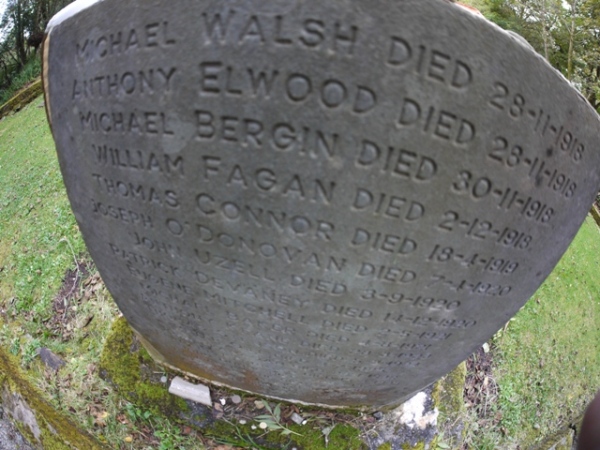 and so on they go. I figure that there are a lot more buried here than there are names for. The cemetery is really a mass grave and this is underlined by the headstone pictured on the right. At one end, a plinth supporting a cross is draped with a tattered and bleached Irish Tricolour. Fitting. There is also a small memorial to the Letterfract boys erected by Connemara National Park.
and so on they go. I figure that there are a lot more buried here than there are names for. The cemetery is really a mass grave and this is underlined by the headstone pictured on the right. At one end, a plinth supporting a cross is draped with a tattered and bleached Irish Tricolour. Fitting. There is also a small memorial to the Letterfract boys erected by Connemara National Park.
I sat down. There was no one else there when I visited. Certainly this was a place to meditate on the wrongdoings that took place at the industrial school. What were these boys’ stories I wondered. How did they come to be sent to Letterfact and how did they die? The graveyards is a peaceful place. Thought has gone into it and it is well maintained. I felt that here at least what happened in the past is both respected and understood. It is good to see that.
LONG REPRESSED, RENDERED INVISIBLE
In a number of location in Ireland right now, a battle is being fought by activists to simply have just this – a proper cemetery such as that that exists at Letterfract.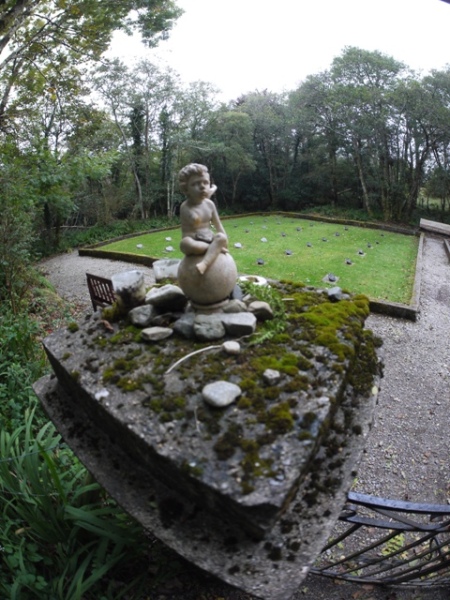 In Tuam (Galway) and in Cork at the Good Shepard Convent (Sunday’s Well) and at the Bessborough Mother and Baby (Blackrock) efforts are underway to identify the full extent of a series of mass graves that are probably located in those places. The situation at Tuam is particularly heart-wrenching. A large number of babies and children’s bodies were dumped in mass grave at the Tuam site without any care to record who they were or to mark their places of burial in any way. These ‘unwanted’ (by Catholic Ireland’s mores) were unceremoniously dumped. The Irish government has been embarrassed into looking into the matter in more detail but it is now claiming that a full and exhaustive excavation of the site would actually cost too much. In the two Cork locations, there is also resistance to efforts to identify and mark who is actually buried at those sites. The Catholic orders and institutions are refusing to make records fully available. Even more telling in the two Cork cases, the property and buildings involved are either in the process of or have actually been sold to private developers who wish to turn these former sites of institutional abuse into apartment complexes. For many it is a race against time to extract the information and prove that these sites must by properly excavated and respected. At least at Letterfract, this small precious cemetery has been salvaged from the steamroller of progress and the process of ‘active forgetting’ at least partially stalled.
In Tuam (Galway) and in Cork at the Good Shepard Convent (Sunday’s Well) and at the Bessborough Mother and Baby (Blackrock) efforts are underway to identify the full extent of a series of mass graves that are probably located in those places. The situation at Tuam is particularly heart-wrenching. A large number of babies and children’s bodies were dumped in mass grave at the Tuam site without any care to record who they were or to mark their places of burial in any way. These ‘unwanted’ (by Catholic Ireland’s mores) were unceremoniously dumped. The Irish government has been embarrassed into looking into the matter in more detail but it is now claiming that a full and exhaustive excavation of the site would actually cost too much. In the two Cork locations, there is also resistance to efforts to identify and mark who is actually buried at those sites. The Catholic orders and institutions are refusing to make records fully available. Even more telling in the two Cork cases, the property and buildings involved are either in the process of or have actually been sold to private developers who wish to turn these former sites of institutional abuse into apartment complexes. For many it is a race against time to extract the information and prove that these sites must by properly excavated and respected. At least at Letterfract, this small precious cemetery has been salvaged from the steamroller of progress and the process of ‘active forgetting’ at least partially stalled.
Such a facility would and could perform a number of functions. Firstly, it would act as repository for all the records related to these institutions of abuse – a place were all the information (print, audio and photographic) can be safely stored and made available for future generations so that they too can learn and understand what happened. Such a place could also facilitate scholarship into what took place and help with explaining how such abuse practices could have taken place. There are still so many aspects to the entire edifice of institutional abuse that we do not fully understand. We need to know a lot more about the perpetrators for example. Who were they, why did the behave as they did, why have they been protected as they have? Thirdly such a facility, if properly structured, could act as a place where we as a society might be able to look at what happened, attempt to understand what happened, and learn more about the legacy of widespread institutional abuse.
We are talking about a shameful period in our history and we need to face up to it. At Letterfract, we can see today what the preferred solution looks like: the past is not hidden away anymore but it is certainly kept at a distance from the public’s eye. It is no longer feasible to say the past didn’t happen – the victims after all have refused to go quietly and won’t be silenced – but Irish society is still happy and comfortable with leaving things largely unseen. At Letterfact you have to search for the past and this is at one of the most infamous of all the abuse institutions in our country.
So if we are to be honest about all of this we need the following:
More Information
Share this:
Written by Kevin Doyle
February 28, 2018 at 4:21 pm
Posted in 2018, Commentary, Cork, New Irish Fiction, Photography, Uncategorized, Writing
Tagged with Berlin, Bessborough, Catholic Church, Child Abuse Commission, Christian Brothers, Connemara National Park, Diamond Hill, Galway, Good Shepard Convent, Horsewhips, Industrial School, institutional abuse, Ireland, Letterfract Industrial School, Letterfract Industrial School Graveyard, Mary O'Malley Poet, Mother and Baby Homes, O'Malley Poet, Over The Edge, Topography of Terror, Tuam